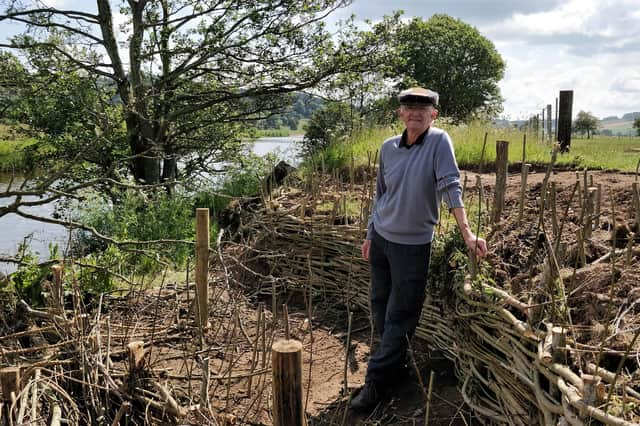A living barrier against the forces of nature


He told me that, as a lad, he often sat precariously on the crag, observing every detail of the River Coquet.
He loved how it curved and flowed, noting its oxbow wetlands: “I always thought of the view as a real world ‘Geography Lesson Illustration’ – it contained so many examples of the power of rivers to transform the landscape”.
Advertisement
Hide AdAdvertisement
Hide AdAs a young man, and, indeed, throughout his life, Alan has often reflected about nature, the environment, and about the mighty power of water.


After retiring, Alan grew willow for basket making. In August 2019, Northumbria Basketry Group began a new willow plot at Chester Hope.
In 2020, the landowner of the plot told Alan about some self-set willow growing on gravel banks at the side of the Coquet.
Alan went along and was delighted to find 4’ tall weaving willow rods, a fantastic discovery for basketry.
Advertisement
Hide AdAdvertisement
Hide AdImportantly to this story, he also noted other types of willow growing nearby.
On Boxing Day, 2020, Alan was shocked to find that the river bank had eroded; the footpath had entirely disappeared! The area looked worryingly changed from how it had appeared on his sunny August walk months earlier.
This was a serious situation. If left unchecked, a large area of fertile pasture land would be lost. Alan notified the Environment Agency (EA) and, after lengthy talks with them, the landowner, and the Parish Council, he began to devise a plan.
Libby Gibson, the Flood and Coastal Risk Management Officer of the EA, was most helpful with this.
Advertisement
Hide AdAdvertisement
Hide AdNow, devising such a plan is no easy task, as Alan discovered.
Studying extensive and comprehensive guidance on how to apply for a bespoke permit for riverbank protection works, Alan waded deeply through rafts of information and necessary ‘red-tape’ before the plan could be finalised.
Rigour was essential as this area is an ‘SSSI’, a Site of Special Scientific Interest – these are the finest sites for wildlife and natural features in England.
Obviously, great care needed to be taken in the development of the strategy.
Advertisement
Hide AdAdvertisement
Hide AdAlan discussed and developed his ideas with the farmer/landowner, Martin Snaith, and with Whitton and Tosson Parish Council. The plan was agreed.
Subsequently, Alan was issued with the required permit to commence the work.
The Coquet had other ideas, however, rising high from heavy rains, to ensure they were unable to begin the work until June 4.
So, what was the plan? Well, remember that Alan had noted the willow growing, earlier in the year?
Advertisement
Hide AdAdvertisement
Hide AdIt was this find that began the process of thinking of a rather different type of willow weaving from basket making.
Alan explains: “Plentiful willow supplies were available nearby, so the use of willow spiling and brash bundles was an obvious choice. Dead trees were also available.
"Because willow takes time to get established, we decided to use levels of spiling protected by substantial bundles of brash lashed to fixed posts and dead trees.
"The lagoon that the river had created in the riverbank was first filled with gravel skimmed from a bank downstream.
Advertisement
Hide AdAdvertisement
Hide Ad“The posts to secure the brash were driven into the gravel close to the water level.
“Next, living willow posts formed the stakes for the willow spiling: willow branches made a robust woven barrier.
“Behind this, we added soil to ensure a growing medium for the live willow.
"We then wove the final spiling barrier and added soil behind this. Finally, this ground was stabilised using willow cuttings.”
Advertisement
Hide AdAdvertisement
Hide AdThe result is very impressive – and I was most interested to see that the dead trees, felled by Michael Boxall, had been secured with substantial manilla rope, which is biodegradable.
Eight community members were involved in all. But I am sure the whole community of Whitton and Tosson will be thankful to Alan, and his team of helpers.
One of the volunteers, Jane Cheadle, who has worked alongside Alan for several years, planting hundreds of trees in Coquetdale, told me: “I felt very inspired by the project, we were all very happy to be part of something so significant, benefitting the whole community.”
I went to have a look at the structure again last week and was thrilled and amazed to see that the willow has already begun to sprout. Because the materials used are natural, and alive, hopefully this barrier will be successful.
Advertisement
Hide AdAdvertisement
Hide AdHowever ingenious, though, we can never be totally sure about how long such work will hold, can we?
Water is a truly mighty force, and the land management further up the valley: deep ploughing and draining, for forest planting, will be helpful to the river, not the humans, as it uses force to go wherever it chooses.
It could be argued that the possibility of torrential rains to come, due to climate change, will mean that nothing less than a full catchment water retention plan should be developed for the future.
I bet that the young Alan dangling his legs from a Simonside crag all those years ago never thought that he would be instrumental in years to come, for developing a plan which endeavours to make the river stay in place, for the time being at least.